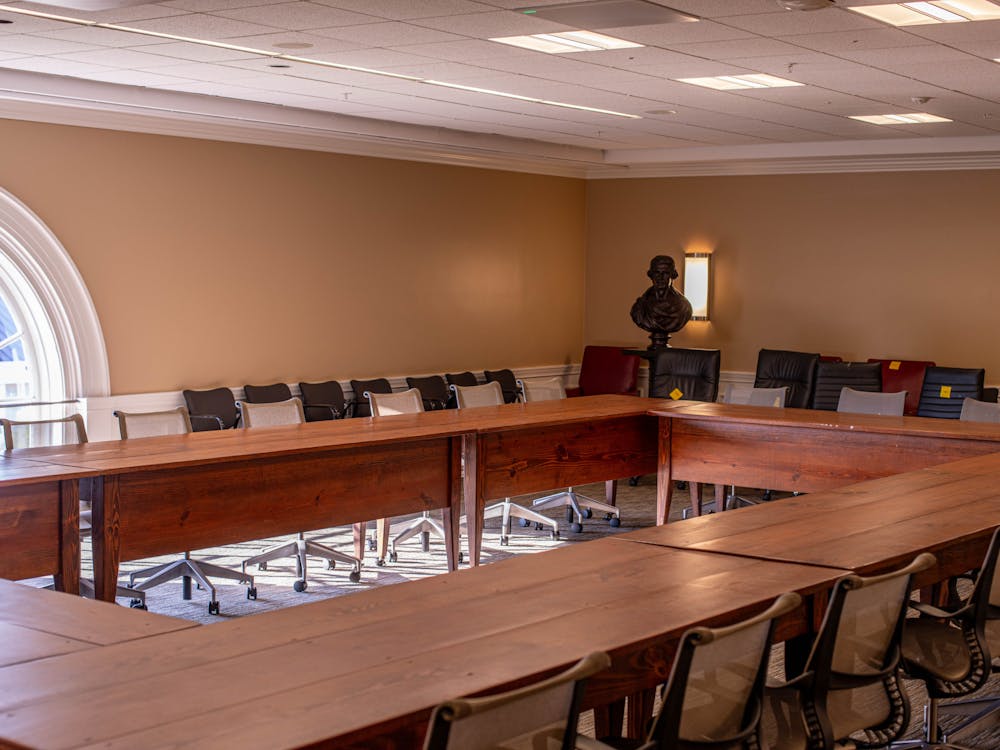When fourth-year students bid goodbye to the University following graduation ceremonies, they will leave behind a campus markedly different than the one they entered as first years.
Wooden fencing, heavy machinery and other telltale signs of construction block views in areas across Grounds, from the Aquatic and Fitness Center on Alderman Road to the future site of the new multi-purpose basketball arena on Massie Road.
There currently are 10 projects in the building process, according to Leonard W. Sandridge, executive vice president and chief operating officer.
"In a normal year, the University might have approximately $200 million under construction; during the next three years, we expect to have about half a billion under construction," Sandridge said.
In addition to the expansion of the AFC and preliminary work on the new arena, construction continues at the Special Collections Library, Observatory Hill dining hall, the footbridge over Emmet Street, the hospital and the Emmet Street parking garage.
This is the most construction the University has ever seen at one time, said University Architect Samuel A. "Pete" Anderson, III.
And more is yet to come.
"If you think there is a lot of construction now, it will be even more noticeable in the next five years," University Landscape Architect Mary Hughes said. "There are a lot of very big projects that have not started construction, but will soon."
Eight projects will begin construction between July 2003 and June 2004, and an additional three remain in the design phase.
The renovation of Cocke Hall, construction of a performing arts center, the South Lawn project and a large addition to Rouss Hall that will accommodate the Commerce School are all in design and planning stages.
Although structural additions and remodeling will significantly alter the face of the University, effort has been made to retain the Jeffersonian touch.
"One of my great goals here has been to reinterpret what to me are the most important aspects of the Academical Village as they apply to an institution a hundred times the size," Anderson said.
An important element of that has been to recognize that the University is now composed of several villages that now need to be connected into a coherent whole, he added.
Calling projects "incredibly complex and well thought out," graduating College student H. Timothy Lovelace, Jr. said he believes the new buildings fit well into the design of the University and the framework of Jefferson's Academical Village.
Lovelace is the former student member of the Board of Visitors and during his tenure sat on the Buildings and Grounds committee, the body responsible for overseeing landscape changes.
"The Buildings and Grounds committee was probably one of the most active committees on the Board in my time, and a lot of debate and meaningful work was put into the planning and design of these projects," Lovelace said. "When they're finished, the University will appreciate them for many generations to come."
For today's students, however, the most apparent change has been the appearance of red fencing.
"For another year or two there's going to be a lot of fences up," Anderson said.
Lovelace said he does not believe the fences have been too much of an inconvenience.
"I think that students are pleased to see the University grow and develop," he said. "Occasionally red walls will be up and traffic will have to be redirected, but the University is good about managing that."
For many fourth years, current development coincides with departure.
"I think the University will be different when a lot of the fourth years come back as alums and it should," Lovelace said. "This University must grow to accommodate the needs of all the members of the University."
The timing of such growth is based largely on funding.
"The buildings you see going up right now are the result of successful private fundraising," Hughes said.
Anderson said he credits the successful capital campaign ending Dec. 31, 2000 for raising the necessary funds.
While private monies are responsible for many of the projects in the building process, some of those yet to begin will be at least partially funded through the sale of state bonds.
According to Anderson, Fayerweather Hall construction will be funded entirely with state bond money and other upcoming projects will have a combination of private and public funds.
All projects have been designed to contain growth without extending too far beyond current boundaries, Anderson said.
"My fervent hope is that all this will enhance the University as a coherent place," Anderson said. "People have worried about adding buildings because they're going to use up open space, but in my opinion, a lot of the open space is not usable or particularly friendly. By building around them and on them, we establish more of a sense of the University as one place."






